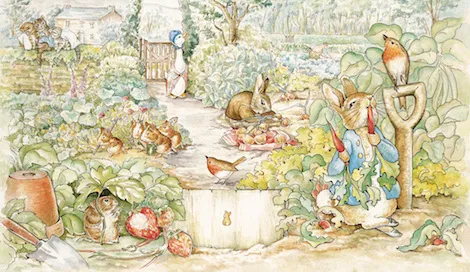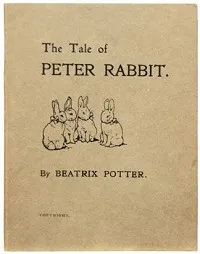
Happy Birthday, Peter Rabbit!
This content contains affiliate links. When you buy through these links, we may earn an affiliate commission.
DID YOU KNOW: 16 December 1901 is the official publication birthday of The Tale of Peter Rabbit by Beatrix Potter? The very first batch consisted of 250 copies privately printed and distributed. In fact, every single one of those 250 privately printed copies is a glorious ‘flip of the bird’ to the industry that said “No”. And as much as I love Peter Rabbit and all the characters from the series, I prefer to celebrate this day as the birth of independent female writers everywhere.
 You can read more of the article here, and you should. Potter knew what she wanted and she knew she simply would have to do it herself. It wasn’t only the private printing of her beloved books; Potter prepared all 41 of the black and white woodblock gravings and the colour frontispiece. She ensured the layout was exactly how she imagined it and funded all the printing of all 250 initial copies of The Tale of Peter Rabbit. Back then, it wouldn’t have been a small amount of money. Today, that same first edition would now be worth around USD$55,500 (going from auction proceedings in 2016).
You can read more of the article here, and you should. Potter knew what she wanted and she knew she simply would have to do it herself. It wasn’t only the private printing of her beloved books; Potter prepared all 41 of the black and white woodblock gravings and the colour frontispiece. She ensured the layout was exactly how she imagined it and funded all the printing of all 250 initial copies of The Tale of Peter Rabbit. Back then, it wouldn’t have been a small amount of money. Today, that same first edition would now be worth around USD$55,500 (going from auction proceedings in 2016).
Hearing the Word, “No”
The Tale of Peter Rabbit was never originally intended to be in book form. Rather, it stemmed from the entertaining letters Potter would send to Noel Moore, the ill child of her former governess. Each of the stories was inspired by her own pets, including a rabbit named Peter. Sometime later, Potter had the idea of publishing the stories in books. And not just any books but a particular style and fashion. Potter could see, in her mind’s eye, the exact way to present these stories to children. The only problem she faced was convincing adults it was a good idea. This was not an easy concept to present to publishing companies. Potter had already had a taste of the misogyny within academia. In 1896, Potter wrote a paper on fungi reproduction. Initially, the Royal Botanic Gardens rejected the paper. However, a year later it was accepted by the Linnean Society when presented by a male colleague but hey–this was the 1890s and apparently, women like Potter were supposed to be accustom to hearing the word “No”. Thankfully, times have been changing and in 1997, the Linnean Society issued a posthumous apology to Potter, acknowledging the sexist treatment given to Potter regarding her research and its policy toward the contributions of women. However, Potter was still in 1897 and she was still having to listen to multiple publishing houses telling her “No”. To any aspiring writers out there, this is going to happen and it’s not always a bad thing. In fact, sometimes we need to hear the word “no” to help refine our work. However, in Potter’s case, the word “no” was more about conforming to predicted consumer behaviour and less about the book itself. Potter had a very set idea in her head as to how this book should be presented. Between this idea and her strong personality, most publishing houses deemed it too difficult.If You Want Something Done Right, You Have to Do It Yourself
Potter always knew what she wanted, and she was never going to ‘settle’ for anything less. Fellow Rioter, LH Johnson, was spot-on when observing the branding genius of Beatrix Potter.“As Potter herself once commented, “with opportunity, the world is very interesting.” She was a woman who realised opportunity and fought hard for the right to realise those opportunities. Her books sing with that awareness of such. Opportunities can be good or bad, but they have to happen. They have to be allowed to happen. For good, or for bad.”
 You can read more of the article here, and you should. Potter knew what she wanted and she knew she simply would have to do it herself. It wasn’t only the private printing of her beloved books; Potter prepared all 41 of the black and white woodblock gravings and the colour frontispiece. She ensured the layout was exactly how she imagined it and funded all the printing of all 250 initial copies of The Tale of Peter Rabbit. Back then, it wouldn’t have been a small amount of money. Today, that same first edition would now be worth around USD$55,500 (going from auction proceedings in 2016).
You can read more of the article here, and you should. Potter knew what she wanted and she knew she simply would have to do it herself. It wasn’t only the private printing of her beloved books; Potter prepared all 41 of the black and white woodblock gravings and the colour frontispiece. She ensured the layout was exactly how she imagined it and funded all the printing of all 250 initial copies of The Tale of Peter Rabbit. Back then, it wouldn’t have been a small amount of money. Today, that same first edition would now be worth around USD$55,500 (going from auction proceedings in 2016).








